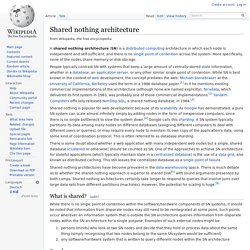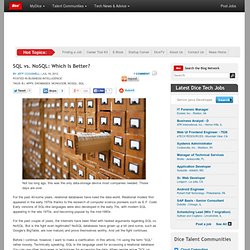

Shard (database architecture) Some data within a database remains present in all shards,[notes 1] but some only appears in a single shard.

Each shard (or server) acts as the single source for this subset of data.[1] A heavier reliance on the interconnect between servers[citation needed]Increased latency when querying, especially where more than one shard must be searched. [citation needed]Data or indexes are often only sharded one way, so that some searches are optimal, and others are slow or impossible. [clarification needed]Issues of consistency and durability due to the more complex failure modes of a set of servers, which often result in systems making no guarantees about cross-shard consistency or durability.
[citation needed] In practice, sharding is complex. Where distributed computing is used to separate load between multiple servers (either for performance or reliability reasons), a shard approach may also be useful. This makes replication across multiple servers easy (simple horizontal partitioning does not). Shared nothing architecture. A shared nothing architecture (SN) is a distributed computing architecture in which each node is independent and self-sufficient, and there is no single point of contention across the system.

More specifically, none of the nodes share memory or disk storage. Shared nothing is popular for web development because of its scalability. As Google has demonstrated, a pure SN system can scale almost infinitely simply by adding nodes in the form of inexpensive computers, since there is no single bottleneck to slow the system down.[4] Google calls this sharding. A SN system typically partitions its data among many nodes on different databases (assigning different computers to deal with different users or queries), or may require every node to maintain its own copy of the application's data, using some kind of coordination protocol. This is often referred to as database sharding. Shared nothing architectures have become prevalent in the data warehousing space. Data warehouse. Massively parallel (computing)
In computing, massively parallel refers to the use of a large number of processors (or separate computers) to perform a set of coordinated computations in parallel.

In one approach, e.g., in grid computing the processing power of a large number of computers in distributed, diverse administrative domains, is opportunistically used whenever a computer is available.[1] An example is BOINC, a volunteer-based, opportunistic grid system.[2] In another approach, a large number of processors are used in close proximity to each other, e.g., in a computer cluster. In such a centralized system the speed and flexibility of the interconnect becomes very important, and modern supercomputers have used various approaches ranging from enhanced Infiniband systems to three-dimensional torus interconnects.[3] The term also applies to massively parallel processor arrays (MPPAs) a type of integrated circuit with an array of hundreds or thousands of CPUs and RAM banks.
Greenplum. Greenplum was a big data analytics company headquartered in San Mateo, California.[1][2] Greenplum's products include its Unified Analytics Platform, Data Computing Appliance, Analytics Lab, Database, HD and Chorus.

Greenplum was acquired by EMC Corporation in July 2010,[3] and then became part of GoPivotal in 2012.[4] Company[edit] Greenplum was founded in September 2003 by Pramukh and Luke Lonergan.[5] It was a merger of two smaller companies Metapa in Los Angeles and Didera in Fairfax, Virginia.[6] Investors included SoundView Ventures, Hudson Ventures and Royal Wulff Ventures. SQL vs. NoSQL: Which Is Better? Not too long ago, this was the only data-storage device most companies needed.

Those days are over. For the past 40-some years, relational databases have ruled the data world. Relational models first appeared in the early 1970s thanks to the research of computer science pioneers such as E.F. Codd. Early versions of SQL-like languages were also developed in the early 70s, with modern SQL appearing in the late 1970s, and becoming popular by the mid-1980s.
For the past couple of years, the Internets have been filled with heated arguments regarding SQL vs. Before I continue, however, I want to make a clarification. Now back to the fight. But what about the programmers, who write the client code that access the databases? So I’d like to take the disagreement into a different direction: Let’s study the problem at the coding level. The Old Arguments Before diving into the code, I want to list some of the more common arguments I’ve seen. Are these valid? NoSQL vs. Weak typing with SQL and Node.JS.